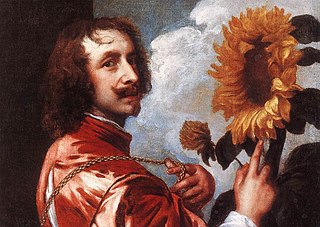
Sir Anthony van Dyck was a Flemish Baroque artist who became the leading court painter in England after success in the Spanish Netherlands and Italy.

Cornelis de Vos was a Flemish painter, draughtsman and art dealer. He was one of the leading portrait painters in Antwerp and is best known for his sensitive portraits, in particular of children and families. He was also successful in other genres including history, religious and genre painting. He was a regular collaborator with Rubens.
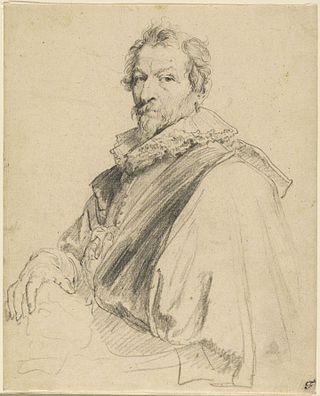
Hendrick van Balen or Hendrick van Balen I was a Flemish Baroque painter and stained glass designer. Hendrick van Balen specialised in small cabinet pictures often painted on a copper support. His favourite themes were mythological and allegorical scenes and, to a lesser extent, religious subjects. The artist played an important role in the renewal of Flemish painting in the early 17th century and was one of the teachers of Anthony van Dyck.

The Picture Gallery in the Sanssouci Park of Potsdam was built in 1755–64 during the reign of Frederick II of Prussia under the supervision of Johann Gottfried Büring. The Picture Gallery is situated east of the palace and is the oldest extant museum built for a ruler in Germany.

The Royal Museum of Fine Arts Antwerp is a museum in Antwerp, Belgium, founded in 1810, that houses a collection of paintings, sculptures and drawings from the fourteenth to the twentieth centuries. This collection is representative of the artistic production and the taste of art enthusiasts in Antwerp, Belgium and the Northern and Southern Netherlands since the 15th century.

Flemish Baroque painting was a style of painting in the Southern Netherlands during Spanish control in the 16th and 17th centuries. The period roughly begins when the Dutch Republic was split from the Habsburg Spain regions to the south with the Spanish recapturing of Antwerp in 1585 and goes until about 1700, when Spanish Habsburg authority ended with the death of King Charles II. Antwerp, home to the prominent artists Peter Paul Rubens, Anthony van Dyck, and Jacob Jordaens, was the artistic nexus, while other notable cities include Brussels and Ghent.

Jan Boeckhorst or Johann Bockhorst was a German-born Flemish Baroque painter and draughtsman. He was a versatile artist who produced history paintings, genre scenes and portraits in a style influenced by the trio of leading Baroque painters in Antwerp Peter Paul Rubens, Anthony van Dyck and Jacob Jordaens. Boeckhorst also worked as a designer of cartoons for tapestries.
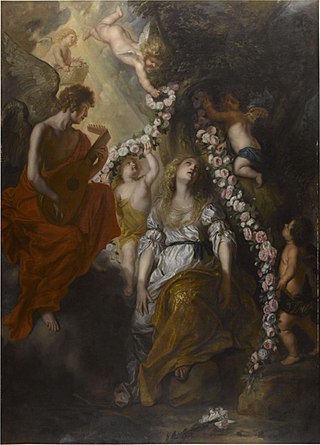
Theodoor Boeyermans, Theodor Boeyermans or Theodor Boeijermans was a Flemish painter active in Antwerp who painted Baroque history paintings and group portraits informed by the tradition of Peter Paul Rubens and Anthony van Dyck.

Willem van Herp (I) or Willem van Herp the Elder (variations on first name: 'Guilliam', 'Gilliam' and 'Guillaume') (c. 1614 in Antwerp – 1677) was a Flemish Baroque painter specializing in religious paintings and small cabinet paintings of "low-life" genre scenes. He operated a large workshop and through his good connections with Antwerp art dealers helped spread the Flemish Baroque style internationally.

Sir Peter Paul Rubens was a Flemish artist and diplomat from the Duchy of Brabant in the Southern Netherlands. He is considered the most influential artist of the Flemish Baroque tradition. Rubens's highly charged compositions reference erudite aspects of classical and Christian history. His unique and immensely popular Baroque style emphasized movement, colour, and sensuality, which followed the immediate, dramatic artistic style promoted in the Counter-Reformation. Rubens was a painter producing altarpieces, portraits, landscapes, and history paintings of mythological and allegorical subjects. He was also a prolific designer of cartoons for the Flemish tapestry workshops and of frontispieces for the publishers in Antwerp.

Schelte a Bolswert (1586–1659) was a leading Dutch engraver, noted for his works after Rubens and Van Dyck.

Still Life with a Chinese Porcelain Jar is a 1669 oil painting by Dutch artist Willem Kalf, located in the Indianapolis Museum of Art, which is in Indianapolis, Indiana. It is a sumptuous still life displaying the sort of costly wares that flowed through the Netherlands during its heyday as a trade center.
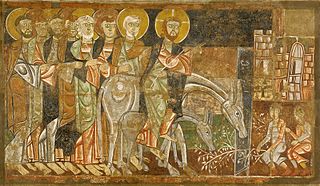
Entry of Christ into Jerusalem is an 1125 fresco by the Master of San Baudelio de Berlanga, originally located at San Baudelio de Berlanga but now on display in the Indianapolis Museum of Art, which is in Indianapolis, Indiana. It depicts Christ and seven disciples entering Jerusalem to the acclaim of its inhabitants.

The Crowning with Thorns is a 1618–1620 painting by Anthony van Dyck. He produced it aged 20 during his first Antwerp period, when he was the main studio assistant and pupil of Peter Paul Rubens. It shows Rubens' influence in its relatively sombre palette, chiaroscuro and highly realistic portrayal of musculature. He seems to have completed it early during his stay in Italy, since it also shows the influence of Titian and other Venetian painters in Jesus' face.

Madonna and Child is a 1621–1627 painting by Anthony van Dyck, now in the Galleria nazionale di Parma.

St Martin Dividing his Cloak is a painting by the Flemish painter Anthony van Dyck dated around 1618, which is an altarpiece in the Sint-Martinuskerk in Zaventem, Belgium. The painting portrays the story of Saint Martin sharing his cloak with a beggar. This early work of van Dyck was painted when he was strongly influenced by Rubens's style.
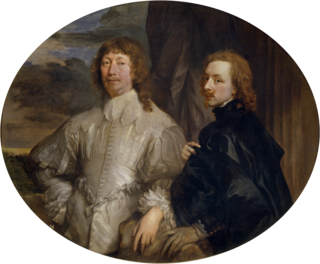
Self-portrait with Sir Endymion Porter is a self-portrait by Anthony van Dyck, showing him with his patron Sir Endymion Porter.

Peeter Symons or Peeter Simons was a Flemish painter only known for his collaboration with Rubens in 1636 on the commission from the Spanish king Philip IV of Spain to create a series of mythological paintings to decorate the Torre de la Parada, a hunting lodge of the king near Madrid.

Jesus Insulted by the Soldiers is an 1865 oil on canvas painting by Édouard Manet, his last religious work. It is now in the Art Institute of Chicago, to which it was left in 1925 by James Deering, heir to the Deering Harvester Company.
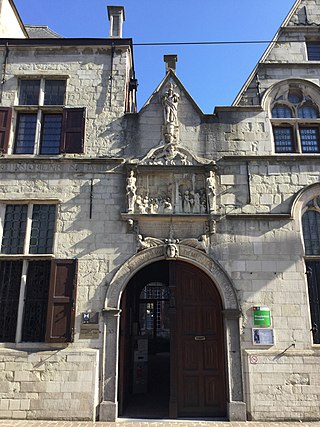
The Maagdenhuis Museum is an art museum and historical museum located in a 17th-century historic building on Lange Gasthuisstraat, Antwerp, Belgium. The building was used as an orphanage for the maegdeckens, or maidens, from the mid-16th century to the end of the 19th century. The museum presents a collection of utensils used on a daily basis by the foundlings and the orphans; a collection of antique furniture, and a series of documents relating to the orphanage and the life in it from the 16th century to 19th century.




















